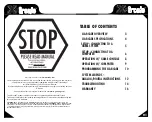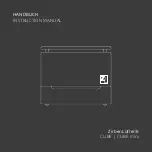
CHAPTER 5: SETTINGS
PRODUCT SETUP
L90 LINE CURRENT DIFFERENTIAL SYSTEM – INSTRUCTION MANUAL
5-121
5
5.3.11.4 Calculation method 3: Rolling demand
This method calculates a linear average of the quantity (RMS current, real power, reactive power, or apparent power) over
the programmed demand time interval, in the same way as Block Interval. The value is updated every minute and
indicates the demand over the time interval just preceding the time of update.
5.3.12 User-programmable LEDs
5.3.12.1 Menu - Enhanced and standard front panels
SETTINGS
PRODUCT SETUP
USER-PROGRAMMABLE LEDS
5.3.12.2 Menu - Graphical front panel
SETTINGS
PRODUCT SETUP
USER-PROGRAMMABLE LEDS
The LEDs can be customized to illuminate when a selected FlexLogic operand is in the logic 1 state. The trip and alarm
LEDs can also be customized in a similar manner. To ensure correct functionality of all LEDs, an LED test feature is also
provided.
5.3.12.3 LED test
SETTINGS
PRODUCT SETUP
USER-PROGRAMMABLE LEDS
LED TEST
If no trigger is assigned in the
DEMAND TRIGGER
setting and the
CRNT DEMAND METHOD
is "Block Interval," use
calculation method 2. If a trigger is assigned, the maximum allowed time between two trigger signals is 60 minutes.
If no trigger signal appears within 60 minutes, demand calculations are performed and available, and the algorithm
resets and starts the new cycle of calculations. The minimum required time for trigger contact closure is 20 µs.
USER-PROGRAMMABLE
LEDS
LED TEST
See below
TRIP & ALARM LEDS
USER-PROGRAMMABLE
LED 1
USER-PROGRAMMABLE
LED 48
USER-PROGRAMMABLE
LEDS
LED TEST
See below
TRIP & ALARM LEDS
EVENT CAUSE LED 1
EVENT CAUSE LED 9
LED TEST
LED TEST FUNCTION:
Disabled
Range: Disabled, Enabled
LED TEST CONTROL:
Off
Range: FlexLogic operand
















































